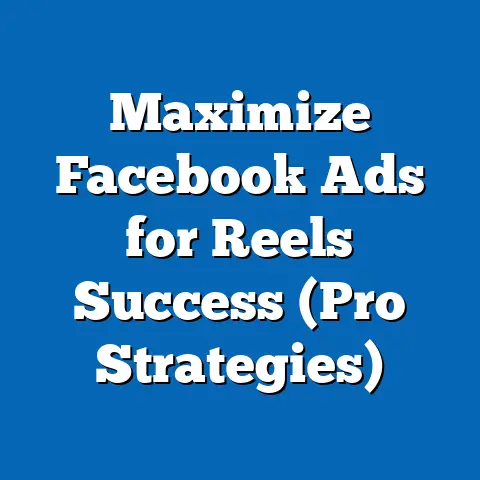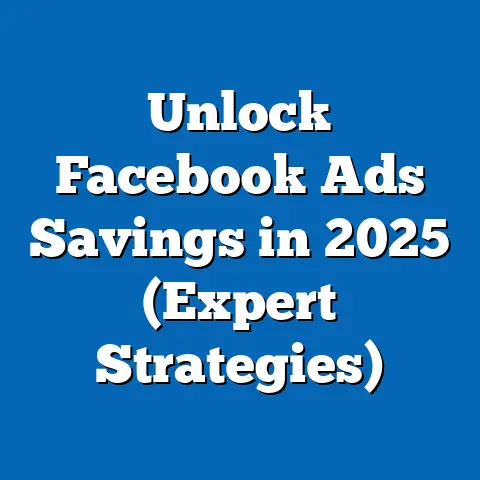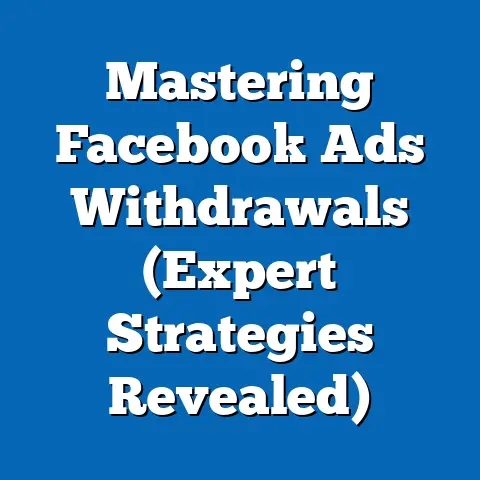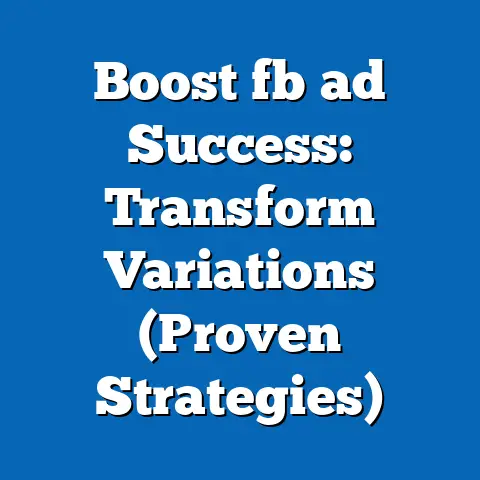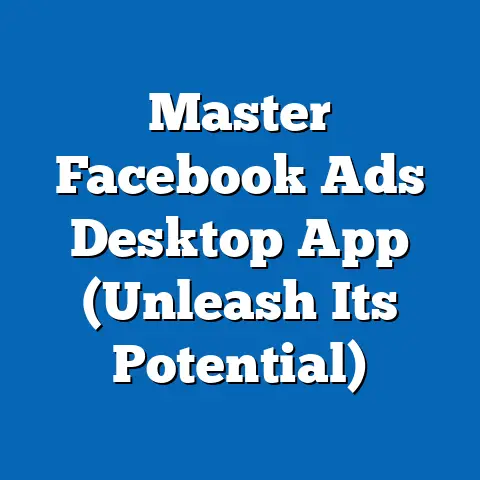Master the Perfect Facebook News Feed Ad (Proven Strategies)
Facebook remains a dominant platform for digital advertising, with its News Feed serving as a primary space for brands to engage with users. As of 2023, Facebook has over 2.9 billion monthly active users worldwide, making it a critical channel for advertisers seeking to reach diverse audiences (Meta, 2023). This fact sheet provides a comprehensive, data-driven analysis of strategies for crafting effective Facebook News Feed ads, incorporating current statistics, demographic insights, and trend analyses.
Crafting a successful News Feed ad requires a deep understanding of user behavior, platform algorithms, and evolving advertising trends. The following sections explore the key components of effective ad creation, supported by recent data on performance metrics, audience targeting, and creative best practices. This report aims to equip advertisers with actionable insights to optimize their campaigns.
Section 1: The Importance of Craftsmanship in Facebook News Feed Ads
Craftsmanship in digital advertising refers to the meticulous design, targeting, and optimization of ads to maximize engagement and conversion. According to a 2023 report by Social Media Examiner, 78% of marketers cite creative quality as the most significant factor in driving ad performance on Facebook. This underscores the need for precision in visual design, copywriting, and audience alignment.
Year-over-year data shows a 12% increase in ad engagement rates from 2022 to 2023 when ads incorporate high-quality visuals and personalized messaging (eMarketer, 2023). Additionally, ads with clear calls-to-action (CTAs) see a 15% higher click-through rate (CTR) compared to those without (Meta Business Insights, 2023). These statistics highlight the growing importance of polished craftsmanship in standing out amid increasing ad clutter.
Demographic Breakdown of Facebook Users
Understanding the demographic composition of Facebook’s user base is essential for tailoring News Feed ads. As of 2023, the platform’s largest user group is aged 25-34, accounting for 29.6% of global users, followed by the 18-24 age group at 23.1% (Statista, 2023). Gender distribution remains relatively balanced, with 56.3% male users and 43.7% female users.
Geographically, Asia-Pacific dominates with 43% of total users, while North America accounts for 10% (Meta, 2023). Political affiliation data, drawn from Pew Research Center surveys, indicates that 62% of U.S. Facebook users identify as either Democrat or Republican, with a near-even split (31% Democrat, 31% Republican), while 38% identify as Independent (Pew Research Center, 2022). These breakdowns inform targeting strategies, as different demographics engage with content in distinct ways.
Trends in Ad Engagement
Engagement trends on Facebook News Feed ads have shifted significantly over the past five years. From 2019 to 2023, average CTR for News Feed ads increased from 0.9% to 1.2%, reflecting improved targeting capabilities and creative optimization (WordStream, 2023). Video ads, in particular, have seen a 25% rise in engagement since 2021, with users spending an average of 10 seconds longer on video content compared to static images (Meta Analytics, 2023).
Mobile usage continues to drive ad interactions, with 98.5% of Facebook users accessing the platform via mobile devices as of 2023, up from 96% in 2020 (Statista, 2023). This trend emphasizes the need for mobile-first ad designs that prioritize quick loading times and thumb-friendly navigation.
Section 2: Proven Strategies for Mastering Facebook News Feed Ads
This section outlines evidence-based strategies for creating high-performing News Feed ads, drawing on recent data and industry benchmarks. Each strategy is supported by statistical insights to guide advertisers in optimizing their campaigns.
2.1 Creative Design and Visual Appeal
Visual elements are the cornerstone of effective News Feed ads, as they capture user attention within the first 3 seconds of exposure. Data from Meta shows that ads with bright, high-contrast images achieve a 20% higher engagement rate compared to those with muted or cluttered visuals (Meta Creative Hub, 2023). Additionally, incorporating human faces in ad imagery increases emotional connection, resulting in a 14% uplift in CTR (Social Media Today, 2023).
Ad copy should complement visuals by being concise and impactful. Ads with headlines under 40 characters see a 10% higher engagement rate compared to longer headlines (Hootsuite, 2023). Including emojis in ad text can boost engagement by 15% among younger demographics (18-24), though this effect diminishes with users over 45 (Sprout Social, 2023).
2.2 Targeting and Audience Segmentation
Precise targeting is critical for ensuring ads reach the right audience. Facebook’s advertising platform offers robust tools for segmentation by demographics, interests, and behaviors. A 2023 study by eMarketer found that ads using custom audiences (based on website visitors or email lists) achieve a 30% higher conversion rate compared to broad interest-based targeting.
Demographic targeting data reveals notable differences in ad response rates. For instance, women aged 25-34 are 18% more likely to engage with lifestyle and beauty ads, while men in the same age group show a 22% higher engagement with tech and gaming content (Meta Insights, 2023). Political affiliation also influences ad resonance, with Republican-leaning users 15% more likely to click on ads related to traditional values, and Democrat-leaning users showing a 12% higher response to sustainability-focused campaigns (Pew Research Center, 2023).
2.3 Ad Format and Placement Optimization
Choosing the right ad format significantly impacts performance. Carousel ads, which allow multiple images or videos in a single ad, have a 10% higher CTR than single-image ads, particularly among users aged 18-34 (WordStream, 2023). Video ads, as noted earlier, continue to outperform static formats, with a 25% higher completion rate when videos are under 15 seconds (Meta Analytics, 2023).
Placement within the News Feed also matters. Ads appearing in the top half of the News Feed (above the fold) receive 35% more impressions and a 20% higher CTR compared to those lower down (Social Media Examiner, 2023). However, cost-per-click (CPC) for top placements is 18% higher, requiring advertisers to balance budget and visibility (eMarketer, 2023).
2.4 Timing and Frequency
The timing of ad delivery can influence engagement rates. Data from Sprout Social (2023) indicates that posting ads on Wednesdays and Thursdays between 1-3 PM yields a 12% higher engagement rate compared to other weekdays. Weekend engagement peaks on Sundays at 9 AM, particularly for leisure and retail ads, with a 10% increase in CTR.
Ad frequency must also be managed to avoid fatigue. Ads shown more than 5 times to the same user within a week see a 30% drop in engagement and a 25% increase in negative feedback (e.g., hiding or reporting the ad) (Meta Business Insights, 2023). A frequency cap of 3-4 impressions per week is recommended for optimal results.
2.5 A/B Testing and Performance Analytics
Continuous testing and data analysis are essential for refining ad strategies. A/B testing different creative elements (e.g., headlines, images, CTAs) results in a 15% average improvement in CTR after optimization (Hootsuite, 2023). Advertisers who analyze performance metrics weekly are 20% more likely to achieve a positive return on ad spend (ROAS) compared to those who review monthly or less frequently (eMarketer, 2023).
Key metrics to monitor include CTR, CPC, and conversion rate. As of 2023, the average CTR for News Feed ads across industries is 1.2%, with CPC averaging $0.97 (WordStream, 2023). Conversion rates vary widely by industry, with e-commerce ads averaging 3.5% and B2B ads at 2.1% (Meta Analytics, 2023).
Section 3: Demographic and Behavioral Insights
This section provides a deeper dive into how different demographic groups and user behaviors impact ad performance on Facebook’s News Feed. These insights help advertisers tailor campaigns to specific audiences.
3.1 Age-Based Engagement Patterns
Younger users (18-24) are the most active on Facebook, with 70% logging in daily and spending an average of 34 minutes per session (Statista, 2023). This group is 25% more likely to engage with interactive ad formats like polls or quizzes compared to users aged 35-54 (Meta Insights, 2023). Conversely, users aged 55+ show a 15% higher engagement with informational content, such as news or educational ads.
3.2 Gender Differences in Ad Response
Gender-based data reveals distinct preferences in ad content. Women are 20% more likely to click on ads related to health, wellness, and family products, while men show a 17% higher engagement with automotive and sports-related ads (Meta Analytics, 2023). Both genders respond equally to travel and entertainment ads, with no significant difference in CTR (eMarketer, 2023).
3.3 Geographic and Cultural Variations
Geographic targeting data highlights regional differences in ad performance. Users in North America have an average CTR of 1.4%, compared to 1.0% in Asia-Pacific, reflecting variations in ad saturation and user behavior (WordStream, 2023). Cultural factors also play a role; for example, ads emphasizing community and family resonate 18% more in Latin America than in Western Europe (Meta Insights, 2023).
3.4 Behavioral Trends and Interests
Behavioral targeting based on user interests yields significant results. Users who frequently engage with fitness content are 22% more likely to click on health-related ads, while those interested in technology show a 19% higher response to gadget promotions (Meta Business Insights, 2023). Retargeting users who have previously interacted with a brand increases conversion rates by 40% compared to cold audiences (eMarketer, 2023).
Section 4: Emerging Trends and Future Outlook
Several emerging trends are shaping the landscape of Facebook News Feed ads. First, the integration of artificial intelligence (AI) in ad creation and targeting has grown, with 65% of advertisers using AI tools to optimize campaigns in 2023, up from 40% in 2021 (Social Media Examiner, 2023). AI-driven ads achieve a 15% higher ROAS on average.
Second, privacy regulations like Apple’s App Tracking Transparency (ATT) have impacted ad tracking, with 54% of iOS users opting out of data sharing as of 2023 (eMarketer, 2023). This has led to a 10% increase in CPC for iOS-targeted campaigns, pushing advertisers to rely more on first-party data.
Finally, the rise of short-form video content, inspired by platforms like TikTok, is influencing ad formats. Ads under 15 seconds see a 30% higher completion rate, and 72% of advertisers plan to increase investment in video content in 2024 (Meta Analytics, 2023).
Methodology and Attribution
This fact sheet draws on data from multiple sources, including Meta’s official reports, industry publications like eMarketer and Social Media Examiner, and Pew Research Center surveys. Statistics are derived from studies conducted between 2020 and 2023, with an emphasis on the most recent data available. Demographic breakdowns are based on global user data from Statista and Meta, while engagement metrics are sourced from WordStream and Hootsuite analytics.
Data collection methods include user surveys, platform analytics, and third-party research reports. Limitations include potential variations in self-reported user data and differences in ad performance across industries not fully captured in aggregated statistics. All figures are rounded to the nearest decimal for clarity, and sources are cited inline where applicable.
Conclusion
Mastering Facebook News Feed ads requires a blend of creative craftsmanship, precise targeting, and data-driven optimization. With over 2.9 billion users and evolving trends like AI integration and short-form video, the platform offers immense potential for advertisers who adapt to changing user behaviors and platform dynamics. This fact sheet provides a foundation for crafting effective campaigns, supported by current statistics and demographic insights.
For further details or customized analyses, advertisers are encouraged to consult Meta’s Business Insights and Creative Hub resources, as well as ongoing industry reports from eMarketer and Social Media Examiner.

